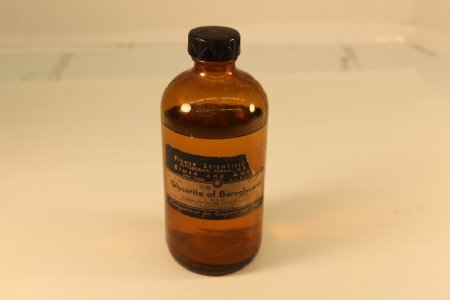Object ID Number:
PH276
Object Name:
Glycerite of Boroglycerin
Manufactured from:
1907
Manufactured to:
1920
Description / History:
Early 20th century brown mold blown glass bottle with bakalite screw on cap. Labeled Glycerite of Boroglycerin, distributed by Elmer and Amend in New York.
As early as 1883, scientific reports recommended boroglycerine as a safe, suitable preservative for a range of foods, including meat, oysters, milk, and butter. Various experiments, including shipping meats dipped in a boro–glycerine solution on long sea voyages, proved successful.
The discovery of a safe means to apply boric acid drew much attention within the medical profession, and by 1835 various experiments, relying on the antiseptic properties of boroglycerine, were being carried out. Ailments ranged from psoriasis, and other scaly conditions of the skin to chilblains, and the search for a treatment of cancer of the uterus.
Boroglycerine found its way into many medicinal products, including shaving creams, in which it was considered a skin conditioner, and applied directly as a lip balm.
Boroglycerine proved most effective as an oral and dental antiseptic. In particular, it is effective in the treatment of mouth ulcers, stomatitis and glossitis. It is also frequently used as a wash for the care of the mouth in unconscious patients.
Boroglycerine, in solution, is used in the treatment of conjunctivitis, earache and ear infections, and is a suitable antiseptic lotion in cases of ophthalmia and diphtheria.
As early as 1883, scientific reports recommended boroglycerine as a safe, suitable preservative for a range of foods, including meat, oysters, milk, and butter. Various experiments, including shipping meats dipped in a boro–glycerine solution on long sea voyages, proved successful.
The discovery of a safe means to apply boric acid drew much attention within the medical profession, and by 1835 various experiments, relying on the antiseptic properties of boroglycerine, were being carried out. Ailments ranged from psoriasis, and other scaly conditions of the skin to chilblains, and the search for a treatment of cancer of the uterus.
Boroglycerine found its way into many medicinal products, including shaving creams, in which it was considered a skin conditioner, and applied directly as a lip balm.
Boroglycerine proved most effective as an oral and dental antiseptic. In particular, it is effective in the treatment of mouth ulcers, stomatitis and glossitis. It is also frequently used as a wash for the care of the mouth in unconscious patients.
Boroglycerine, in solution, is used in the treatment of conjunctivitis, earache and ear infections, and is a suitable antiseptic lotion in cases of ophthalmia and diphtheria.
Dimensions:
H–6.25 Dia–2.75 inches
